Reviews
George Sidney
USA, 1952
Credits
Review by Matt Bailey
Posted on 29 June 2009
Source Warner Brothers DVD
Categories Favorites: The Action Movie
There is nothing particularly unique or innovative about George Sidney’s 1952 film of Scaramouche, based on the novel by Rafael Sabatini. Nothing in the film had not already been done in dozens of previous films starring Douglas Fairbanks, Errol Flynn, or Tyrone Power, and, in fact, this story had already been filmed by MGM once before as a silent starring Ramon Novarro. What makes this particular film interesting is that it is at once an extraordinarily well-crafted example of the “swashbuckler” genre with a literate and witty script and enthusiastic cast, a sparkling piece of MGM entertainment from when the studio was at the height of its powers, and an extremely fun way to spend two hours.
George Sidney worked at MGM for decades, legendarily starting out as a messenger and cutting his teeth as a director on Our Gang shorts before moving up to musicals. Sidney directed a handful of beloved but minor musicals (including Thousands Cheer, Anchors Aweigh, and The Harvey Girls) and was then given the assignment to direct a lavish Technicolor version of The Three Musketeers, an apparent attempt to cash in on the revivified swashbuckler genre of films that was bringing in sacks of cash for Fox and Warner Bros. MGM being MGM, though, and Sidney being Sidney, Musketeers felt less like an Errol Flynn adventure film than a Gene Kelly musical without songs: it’s light, playful, and romantic, emphasizing the boisterous and carefree character of the Musketeers and downplaying the dark historical underpinnings of the story. The film was an enormous hit, and when MGM decided to repeat the success, they turned to Sidney once again.
The novels of Rafael Sabatini had been the basis of some of the biggest successes in the careers of Errol Flynn (The Sea Hawk, Captain Blood) and Tyrone Power (The Black Swan). MGM had already seen the box office potential in Sabatini’s work with their 1923 version of Scaramouche and so, already having the rights, set out to produce a remake. Stewart Granger had already proven his worth as a replacement for Errol Flynn in 1950’s King Solomon’s Mines and was a natural to be cast in the title role. Hollywood legend has it that Elizabeth Taylor was considered for a role in the film but was already scheduled to have her talents wasted in Ivanhoe, which filmed concurrently with Scaramouche. If her absence opened up the role of Lenore for Eleanor Parker, so much the better. It’s hard to imagine anyone else in the part, even if it is firmly in the mold of other feisty MGM redheads such as Janis Paige and Lucille Ball (not to mention Fox’s Maureen O’Hara). MGM filled the rest of the roles with contract players (including Lewis Stone, who appeared in the earlier Scaramouche film), yet could not have chosen a better villain if they had their pick of Hollywood talent. Mel Ferrer, a trained dancer who learned his fencing moves as if they were dance numbers, had only appeared in a handful of films. In Scaramouche, where his character of the Marquis de Maynes is introduced gleefully skewering an opponent in a duel, Ferrer takes every chance to give a career-making performance and succeeds. Because of the film’s added layer of theatricality thanks to several scenes being set onstage and backstage with a pantomime troupe, the performances of the actors are allowed to be a little more comedic or exaggerated, perhaps even a little more campy, than might be expected in a standard swashbuckler. The film revels in the nature of performance and layers of identity, and so it is no accident that the climactic six-and-a-half-minute duel takes place in a sumptuous Paris theater.
As in the best of all swashbuckling action films from the era of Douglas Fairbanks to the era of Orlando Bloom and Johnny Depp, Scaramouche hops along from scene to scene, providing just enough characterization for us to root for the hero and to hiss the villain, intermingling daring physical feats with a touch of romance and humor, and rooting the plot in history without turning the film into a tedious history lesson. Though it might not be as famous as similar films of the same era, it is a spectacular bit of filmmaking in a genre that appears as old and as endurable as cinema itself.
More Favorites: The Action Movie
-

First Blood
1982 -
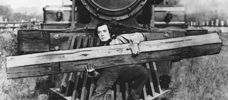
The General
1926 -

The Running Man
1987 -

Guns
1990 -

Highlander
1986 -
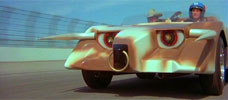
Death Race 2000
1975 -
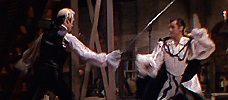
Scaramouche
1952 -

Do or Die
1991 -
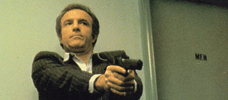
Thief
1981 -

Mission: Impossible
1996 -

Invasion U.S.A.
1985 -

Rambo: First Blood Part II
1985 -

Bullitt
1968 -

Hard Hunted
1992 -

The Fugitive
1993 -
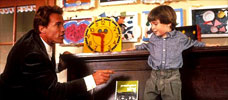
Kindergarten Cop
1990 -
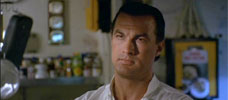
Under Siege
1992 -
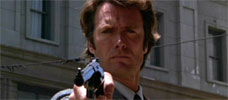
Dirty Harry
1971 -
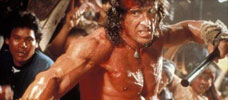
Rambo III
1988 -
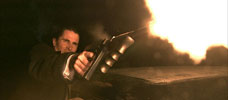
Public Enemies
2009 -
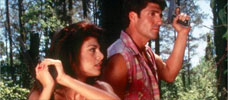
Day of the Warrior
1996 -

The Good, the Bad, the Weird
2008 -

Straw Dogs
1971 -
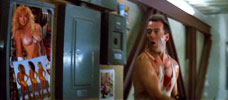
Die Hard
1988 -

Con Air
1997 -

Collateral Damage
2002 -
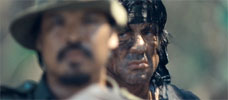
Rambo
2008
We don’t do comments anymore, but you may contact us here or find us on Twitter or Facebook.



